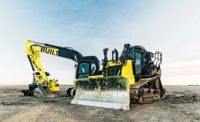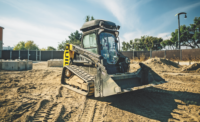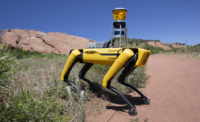When building solar farms in remote locations, driving materials around the often sprawling sites can be time consuming. To reduce the number of trips on a New Mexico solar site, Black & Veatch ran a pilot test of the Honda Autonomous Work Vehicle (AWV), a four-wheeled platform that can carry or haul materials and tools to preset locations without an operator.
“The trial that we did exceeded our expectations,” says Paul Skurdahl, senior vice president and solar lead at Black & Veatch. “We were unsure of how useful it would be, but we were able to immediately put it to work in a way that was useful for our site work.”
Each Honda AWV has an onboard payload of 800 lb and a towing capacity of just over 1,600 lb, so Skurdahl initially had them hauling trash and water around. But soon it was clear these machines could deliver construction materials and equipment just as efficiently, saving workers the trouble of driving back and forth across the solar power installation site.
The AWV’s onboard lithium-ion battery offers the machine a range of 28 miles, and the battery can be fully charged in six hours off a standard 120V outlet. Navigation is performed via GPS, onboard radar and LiDAR, with stereo-mounted cameras remote monitoring. A GPS base station set up on site is the only external piece of equipment the AWV needs to navigate its routes. The AWV does need a relatively strong wireless network set up on site as well, and can rely on cellular networks if needed.
Honda first unveiled the prototype of the AWV in 2018, and Black & Veatch tested out the second generation model for this pilot, explains Kenton Williams, Honda’s U.S. project lead for the AWV. “We’ve designed a very versatile off-road system with many different capabilities,” he says. “Its main job is payloads, but there could also be opportunities for a suite of attachments for different purposes.”
The off-road focus of the AWV allows for Honda to avoid the challenges of fully autonomous navigation in live traffic, and Williams says that while the vehicle can navigate from point A to point B, Honda prefers to have humans program the routes rather than let an AWV blaze its own path to its destination.
Aside from having to occasionally clear dust from the sensors, Skurdahl says there were hardly any issues with the AWV. Williams says the latest version of the AWV is even better at navigation, and that Honda is still looking for partners in the construction industry to test out and further its development.






Post a comment to this article
Report Abusive Comment